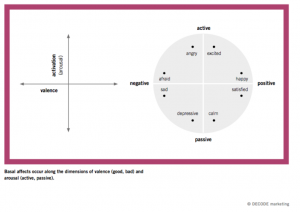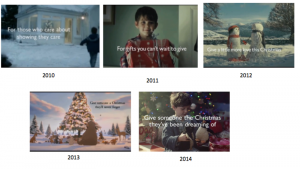“Emotion is everything” for effective communication according to many experts. The IPA prominently promote “the power of emotion in ad campaigns”, for example (1).
However, this view is “an over-simplifcation (that) carries the risk of creating an ad which people love, but which does not sell,” according to the latest Science Update from Phil Barden and the team at Decode (2).
We’ve been writing for years about the need to combine emotional ‘sizzle’ with product ‘sausage’. So I was chuffed to bits that the paper provided some scientific evidence to back this up, as I discuss below.
1. What the hell are emotions anyway?
The word ‘emotion’ is thrown around a lot in marketing, without it being fully understood.
“First and foremost, emotions are a physiological response to something we experience or anticipate,” explains the Decode paper. Emotions prepare our bodies to cope with situations by changing our heart-beat, blood pressure, muscle tension etc., with two main dimensions:
i) arousal – intensity of response
ii) valence – whether something is positive or negative
We construct ‘feelings’ (‘love’, ‘hate’, ‘jealousy’, ‘anger’ etc.) to make sense of emotions, experiencing different feelings for the same emotion depending on our experience, personality and culture. So, I might feel scared witless by the emotional response from bungee jumping, whereas you might feel joy.

2. How emotion CAN drive effectiveness
High emotional arousal increases attention and sharpens our senses, so we can deeply process what is triggering the emotional response. In prehistoric times this was, “S**t, a tiger!” For us, it might be, “Oooh, is this the new Nike ad?” And deeper processing does mean we’re more likely to remember an ad (science bit: it triggers the ‘amygdala’ area of our brain, that it turn encourages the adjacent ‘hippocampus’ to store the information).
Emotionally engaging ads are also more likely to be shared.
However, the watch-out here is ‘sponsored entertainment’: emotionally arousing communication with bugger all link to the brand and product, such as Budweiser’s Puppies ad from the 2015 SuperBowl. The Decode paper quotes Jorn Socquet, VP for Marketing at A-B InBev, saying that while everybody loved the puppies “they have zero impact on beer sales”. As the paper rightly points out, “To leverage the potential of the arousal the brand/product needs to be the ‘agent’ that triggers the response.”
To note, communication evoking a positive emotional response is more likely to be shared than negative.
3. MOTIVATION: what really matters
Its one thing for an ad to be remembered and shared. But what really drives behaviour and brand choice?
Well, its not emotion per se, according to an evaluation of 3,000+ scientific papers quoted by Decode. This found no causal relationship between emotion and behaviour, except in extreme cases.
Buying behaviour is actually driven by ‘motivation’: desires, needs and ‘jobs to be done’. We choose brands, services and products that help us achieve these goals. Emotion is then the feedback mechanism that confirms a given decision has helped meet our motivations (science bit: managed by the ‘orbito-frontal cortex’ (OFC) in the brain).
Phil gives the example of ordering food in a restaurant. “You adore a burger, so your emotional response to the burger on the menu is high/positive. And if your goal is indulgence then you’ll have the burger. But, if your goal is to lose weight, you might choose a salad instead.”
4. Using all this to SMS (sell more stuff)
The paper confirms that to have the best chance of effective communication we need to combine emotional ‘sizzle’ (HOW) AND product ‘sausage’ (WHAT) :
- Emotional sizzle/How: leverage the power of emotional response to optimise attention, recall and likelihood of sharing
AND
- Product sausage/What: position the brand as an effective way of achieving a goal (functional, social or feelings-based)
Importantly, the brand should be the hero, not just a logo slapped at the end of the ad, in terms of both: i. the role it plays in the story, and ii. distinctive ‘assets’ (colour, executional style, logos, endlines, music etc.) to build memory structure.
The paper uses the long-running John Lewis Christmas ad campaign we posted about here as an example of getting this right:
- Emotionally engaging execution (How): use of endearing characters, music, narrative
- Brand story (What): positions John Lewis as the way to give a little more love at Christmas, by shopping at John Lewis for your gifts
- Brand as hero: consistent narrative structure, style of music, visual style all help create distinctive memory structure, and the John Lewis gift always plays a central role

In conclusion, thanks to Decode team for a data and science-based report that confirms how effective communication comes from the triple whammy of: sausage + sizzle + brand as hero = distinctive memory structure that sells more stuff.
Find out about thebrandgym’s wide range of brand strategy consultancy services.
Sources:
(1) http://www.ipa.co.uk/news/powerfully-emotional-advertising#.Wp5XAmaca8U
(2) Sign up at: https://decodemarketing.com/en/science-update
